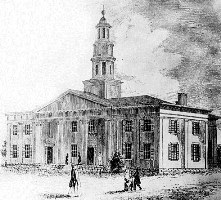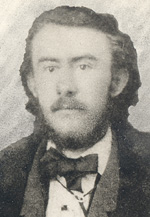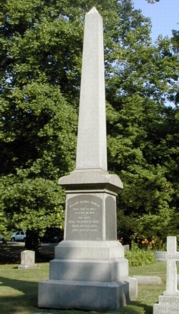By Towner Blackstock (Davidson 1994), Curator of Archives
June, 2010
Back to History Articles page
Phi Gamma Delta had a brief life at Kentucky University in Harrodsburg, Kentucky at the start of the American Civil War.
 Kentucky University was founded by the Disciples of Christ, and operated in the old Bacon College building (shown at right, from a picture at the University of Kentucky). The first college session opened September 19, 1859. The annual catalogue of 1859 lists 120 in the University, with others in the preparatory department, known as Taylor Academy, which had already operated for a couple of years. This was an auspicious beginning. In antebellum times this was a sizeable enrollment.
Kentucky University was founded by the Disciples of Christ, and operated in the old Bacon College building (shown at right, from a picture at the University of Kentucky). The first college session opened September 19, 1859. The annual catalogue of 1859 lists 120 in the University, with others in the preparatory department, known as Taylor Academy, which had already operated for a couple of years. This was an auspicious beginning. In antebellum times this was a sizeable enrollment.
For all the hopeful beginnings of Kentucky University, the skies soon darkened. The fractious presidential election held November 6, 1860 resulted in the choice of Republican Abraham Lincoln. Furor erupted across the slaveholding South. South Carolina seceded from the United States in December, and other states followed over the next few months. The Civil War broke out in April, 1861.
Kentucky was a slave state. Although it did not secede from the United States, there was great fear that it would. The governor tried to proclaim it as neutral between the United States and the fledgling Confederacy. Kentucky became a battleground, with its populace both split in sentiment and between the armies in which they served.
Of course these events had a profound impact on Kentucky University. The University attendance of 120 in 1859-1860 declined to 101 in 1861-1862 and 77 in 1862-1863. Many students departed for military service, as they did across America.
 The Grand Chapter minutes of October 31st, 1860 state,This was the environment in which Phi Gamma Delta's Rho Chapter as founded. The impetus seems to have come from James Q. "Jim" Chenoweth (Indiana Asbury 1860), pictured to the left. A native of Harrodsburg, the nineteen year old Chenoweth graduated from what is now DePauw University in June 1860, having served as both chapter president and a delegate to the Fraternity's 1859 convention in Louisville. Four months later he sent a petition for charter to the Grand Chapter at Jefferson College, Canonsburg, Pennsylvania. Whether the idea originated with him, or if he was approached by the petitioners, we do not know.
The Grand Chapter minutes of October 31st, 1860 state,This was the environment in which Phi Gamma Delta's Rho Chapter as founded. The impetus seems to have come from James Q. "Jim" Chenoweth (Indiana Asbury 1860), pictured to the left. A native of Harrodsburg, the nineteen year old Chenoweth graduated from what is now DePauw University in June 1860, having served as both chapter president and a delegate to the Fraternity's 1859 convention in Louisville. Four months later he sent a petition for charter to the Grand Chapter at Jefferson College, Canonsburg, Pennsylvania. Whether the idea originated with him, or if he was approached by the petitioners, we do not know.
A petition signed by Bro. J. Q. Chenoweth for the establishment of a Chapter at the University of Kentucky, was presented . . . . It was moved and seconded that the charter be granted. After some discussion the motion was lost, on the ground that as there were but four names signed to the petition we did not possess the power to grant it.
They requested that Chenoweth submit a petition with at least five petitioners, as required by the Fraternity's Constitution. The Grand Chapter received it and granted the charter on November 9. The charter members were John M. Askew, William C. Goodloe, George C. Mullins, Micah C. Saufly, and Samuel R. Smith.
No further mention is found in the minutes of the Grand Chapter regarding Kentucky University, so it is not known when Chenoweth installed the chapter. Unfortunately the Grand Chapter minutes feature a gap from December 11, 1860 to May 9, 1861.
The University's 1859 catalogue lists one future brother enrolled in Taylor Academy for the session ending in 1859, and nine as University matriculates for the 1859-1860 year. The 1861 catalogue shows all eleven known Phi Gams enrolled for 1860-1861. In June 1861 the University celebrated its first commencement with three graduates. All were Phi Gams: Charles R. Harrison, Samuel R. Smith, and Alexander Milligan, the son of University President Robert Milligan.
Less than a year after its founding, the chapter seems to have declined. Many students left school to enlist in either Union or Confederate forces. Only three remained for the 1861-1862 year. One graduated in 1862 (one of three University graduates that year), and another departed school. The last was as a tutor.
It is doubtful that the chapter lingered on in any fashion, given the decline in enrollment, turnover in students, and from what we know about chapter survival in other southern schools during wartime. Rho Chapter was never reestablished.
Alexander Milligan tutored at Taylor Academy for four years after his graduation. The university building burned in 1864. Kentucky University then moved to Lexington and merged with Transylvania University, retaining the former’s name. Kentucky University also fostered the Agricultural & Mechanical College of Kentucky as a department until 1878, when A&M became separate; today it is known as the University of Kentucky.
With the move to Lexington, Milligan became a professor and taught until 1911. He was also acting president of Kentucky University in 1900 and 1901. A few years later the school was renamed Transylvania University. It remains today as a small, selective liberal arts college.
The University's longest-serving president was Charles Shearer (Kentucky 1965), who retired in June, 2010 after 27 years in office.
Initiates
The following list of initiates shows name, residence and attendance as given in University catalogues. Charter member status and officer positions taken from Fraternity catalogues. Of course, a student may have withdrawn during the school year, as did Cassius Goodloe. Further research may reveal more details. Please send additions/corrections to the Curator of the Archives.
Askew, John Maffitt, Harrodsburg, Ky. 1859-61. Charter member. Chapter president. Born about 1838 or 1842 (depending on whether referring to his age as listed in the 1850 or 1860 census) to Louisa Fitzallen Trower and Eyre Askew, who was principal of Bacon College's preparatory department in the 1840s, and a tutor at Taylor Academy in 1859. The 1870 census shows him living with his mother and sister Martha, working as an attorney. The age is shown as 25, which would make him born in 1845. Not one of the three censuses has a consistent age for John or his siblings. His brother James Fields Askew also attended Kentucky.
Goodloe, William Cassius,
 Lexington, Ky. 1859-60, 1860-61. The National Cyclopedia of American Biography, Volume VII, 1892, states: "...born in Madison county. Ky., in 1841, son of D. S. Goodloe, a merchant. .... left it before graduation [ourChapter Rolls and Directory says he left in May], in 1861, to accompany his uncle, Cassius M. Clay, to St. Petersburg, Russia [Clay was U.S. Ambassador]. While there he acted as secretary of legation, and upon returning home the following year entered the Federal army [serving as Captain and A.A.G.]. In January, 1864, he resigned, and commenced the practice of law in Lexington, Ky. Three years later he started the "Kentucky Statesman" for the advocacy of the principles of the Republican party, and in 1868 was elected a delegate to the Chicago national convention that nominated Gen. Grant for the presidency. He represented Fayette county in the Kentucky legislature in 1871, being chosen speaker of the house, and in 1873 became a member of the state senate. He was a prominent and influential member of the Republican national convenlions in 1872, 1876, and in 1888, each time being elected by the Kentucky delegation to represent his state on the national committees. In 1878 [to 1880] he held the post of U. S. minister to Belgium.... married in June, 1865, to Mary E., daughter of Samuel Man, of Manville, R. I. He died in Lexington, Ky., Nov. 10, 1889." His death was the result of an altercation with another prominent citizen at the Lexington Post Office; both men died of their wounds. Buried in Lexington Cemetery, Section A, Lot 81 (picture on left).
Lexington, Ky. 1859-60, 1860-61. The National Cyclopedia of American Biography, Volume VII, 1892, states: "...born in Madison county. Ky., in 1841, son of D. S. Goodloe, a merchant. .... left it before graduation [ourChapter Rolls and Directory says he left in May], in 1861, to accompany his uncle, Cassius M. Clay, to St. Petersburg, Russia [Clay was U.S. Ambassador]. While there he acted as secretary of legation, and upon returning home the following year entered the Federal army [serving as Captain and A.A.G.]. In January, 1864, he resigned, and commenced the practice of law in Lexington, Ky. Three years later he started the "Kentucky Statesman" for the advocacy of the principles of the Republican party, and in 1868 was elected a delegate to the Chicago national convention that nominated Gen. Grant for the presidency. He represented Fayette county in the Kentucky legislature in 1871, being chosen speaker of the house, and in 1873 became a member of the state senate. He was a prominent and influential member of the Republican national convenlions in 1872, 1876, and in 1888, each time being elected by the Kentucky delegation to represent his state on the national committees. In 1878 [to 1880] he held the post of U. S. minister to Belgium.... married in June, 1865, to Mary E., daughter of Samuel Man, of Manville, R. I. He died in Lexington, Ky., Nov. 10, 1889." His death was the result of an altercation with another prominent citizen at the Lexington Post Office; both men died of their wounds. Buried in Lexington Cemetery, Section A, Lot 81 (picture on left).
Harrison, Charles Robinson, Fayette Co., Ky. 1859-61. A.B. 1861. Deceased prior to 1896. June, 1860 census for Lexington finds one Charles Harrison, 19 years old, son of Cathering F. and George B. Harrison, a farmer. Unfinished catalogue notes he was Confederate soldier, "Died in service in Tennessee, 1862."
Milligan, Alexander Reed, Harrodsburg, Ky. Attended 1859-61. A.B. 1861; A.M. 1864; LL.D. 1902. Son of Robert Milligan, first president of Kentucky University, and Eleanor Blaine Russell. Born Washington, PA December 21, 1842. Attended Indiana University and Bethany College. Worked at Kentucky University 1861 to 1911: Taylor Academy tutor 1861-1865, adjunct professor 1865-1870, full professor until his retirement. Acting president of Kentucky Unversity 1900-1901. Died 1913, age 70. Interred at Lexington Cemetery, Section J, Lot 40, Part S.
Moore, John Whiting, Fayette Co., Lexington, Ky. 1859-61. Unfinished catalogue notes him as "C.S.A." for Confederate States Army, but gives no other details. There are two John Moores in the July 1860 census for Lexington, one 15 years old and the other 21.
Mullins, George Gatewood, Richmond, KY. 1859-62, A.B. 1862. A.M. Canton University (Missouri); LL.D. Bethany College. Charter member. Chapter secretary. Born Harrodsburg on April 1, 1841. Died 1909, Los Angeles, CA. According to an unattributed newspaper article in the Transylvania University library, he was ordained by the Christian church after graduating. "....He took charges at Covington, Louisville, Suracuse, Philadelphia, Chicago, and Denver. On July 24, 1866, the young minister was married to Miss Mary Virginia Sparr of St. Louis.... in 1875 President Grant appointed the minister as a Captain in the United States army...." He was assigned as a chaplain to the 24th Infantry (Buffalo Soldiers) and became a pioneering advocate for education within the military. He was put on detached assignment to support, and in 1881 took charge of all army schools. He retired from the army in 1891 due to ill health. He subsequently invented "the Mullins process for hardening iron...." and served as president of various mining firms.
Saufley, Micah “Mike” Chrisman, Monticello, Ky. 1860-61. Charter member. Chapter treasurer. According to Lincoln County, Kentucky (Turner Publishing Company, 2002): “....born in Monticello, Wayne County, KY, May 13, 1842.... born to Henry Rinehart Saufley (1771-1844) and Emily Chrisman Saufley.... reared and educated in Wayne County after which he attended the University of Kentucky when it was located in Harrodsburg. In 1861, when the Civil War began, Micah left... to enroll in the Confederate Army.... joined the command of General Felix Zollicoffer.... Micah was transferred to Co. "H", Sixth Kentucky Cavalry [enlisting January 24, 1862 in Livingston TN].... Saufley was captured at Cheshire, OH during the raid on July 20, 1863.... After spending two years in three prisons, Lieutenant Saufley was exchanged in February of 1865 and he was on his way to join General Duke's command in Virginia when the war ceased.... [attended] Louisville Law School and was admitted to the bar in 1869. He moved to Stanford in 1868, was elected and served as judge of Lincoln County from 1870-1874.... In 1880 Micah was a presidential elector of Kentucky supporting the Hancock ticket. He was also Kentucky State Auditor.... also president of the Stanford Water, Light & Ice Company.... appointed ... Associate Justice of the Supreme Court of the Territory of Wyoming in 1888.... In November 1892, Saufley was elected to the circuit bench of the 13th Judicial District [Kentucky].... unable to fulfill the last term as a fatal heart attack took his life on Aug. 12, 1910 at his home in Stanford.... married Sallie Rowan of McMinnville, TN shortly after the Civil War....” Interred Buffalo Springs Cemetery outside Stanford KY.
Sea, Robert Winston, Jr., Harrodsburg, Ky. Taylor Academy session ending 1859. 1859-62. Born July 1, 1844 to Robert Winston Sea and Mary Jane McBrayer. His father died and Mary married Dixon G. Dedmon in 1848. She died in 1857. The 1860 census finds Robert and his brother Andrew living with Mary E. and Sandford McBrayer, their mother's brother. Robert Married Amelia Grimes on November 10, 1864. In 1870 they were living with her parents in Harrodsburg; he was occupied as a farmer as was his father-in-law. She died in 1874. The 1880 census finds him and four children still with his in-laws. His occupation is listed as "shoe merchant." Moved to Wellington, Sumner Co., Kansas in 1886. A letter to a Kentucky newspaper in 1887 notes that he is associated with a real estate firm. The 1895 Kansas state census shows R. W. Sea of Kentucky, a "Com. Traveler" by occupation, living with his son 23 year old Robert G. Sea, a printer. The 1910 census shows him retired as a traveling salesan of flour, living with his daughter Minna and her husband Charles Hood in Hutchinson, Reno Co., Kansas. He died September 14, 1912. The 1895 and 1910 censuses do not note any military service.
Smith, Samuel Rogers, Danville, Ky. 1859-61, A.B. 1861. Charter member. Kentucky University's newspaper, The Colverleaf, of December 20, 1896 states he was class valedictorian. Son of Margaret and Dr. Joseph Smith. According to Kentucky University Alumni Book by George Whitefield Kemper: "Born Sept. 13, 40. Also attended Centre College. After Civil War licensed to practice law. Editor Danville Gazette, '66-7; Frankfort (Ky.) Commonwealth, '67-'72; Lexington (Ky.) Statesman and Herald, '72-4.... From '75-9 was in U.S. Revenue Service; from '80-'93 was connected with E.H. Taylor Jr. & Co. and the Geo. T. Stagg Co., in the capacities of Secy., Treas. V.Pres. and Supt. Member Franfort City Council two years, also of Police Commission. Now Commissioner Ky. Inst. for Feeble Minded Children and also engaged in Bureau of Claims Dept. Auditor's Office, Frankfort, Ky." Died March 3, 1914 at City Hospital in Louisville, KY and was buried in Frankfort (source: death certificate). Unfinished Catalogue states served in the Union Army, "Kentucky Home Guard, '61-'62; Clerk, U.S. Mustering Officer, Camp Nelson, Ky., '64-'65...."
Tucker, James Edwin, Warren County, KY. 1860-61. He is the only one other than charter memers to appear in the 1862 catalogue. According to Colonial Virginians and their Maryland Relatives: A genealogy of the Tucker Family, by Norma Tucker (1994): "James Edwin Tucker, M.D., born 11 October 1839; died 2 April 1890; married 14 November 1864 Callie Jane Moore [1842-1924]. . . . attended the common schools until age 19, then entered Union University at Murfreesboro, TN and subsequently finished his literary education at Harrodsburg. He began the study of medicine at Ohio Medical College at Cincinnati and afterward attended Jefferson Medical College, Philadelphia, where he was graduated in 1864. Immediately he established his medical practice in Oakland, Warren Co., KY, then removed to Louisville, but returned two years later to Oakland.” Son of James Monroe Tucker (1808-1889). Interred, Smith’s Grove Cemetery.
Wheatley (Wheatly), Richard Robertson, Mayslick, KY. 1859-61, 1864-65. 1850 census for Mayslick, Mason Co. KY, shows father Francis W. Wheatly, farmer, native of Maryland, and mother Mary A., native of Kentucky. By the June, 1860 census Mary is widowed and Richard and two of his brothers are working on the family farm (the oldest is a surveyor). In March, 1868 Jefferson Medical College graduated one Richard R. Wheatly of Kentucky. 1870 census, he's a physician in Lexington, freshly married to Sallie. 1880 finds them back in Mayslick. 1900 they are in Lexington, where Sallie keeps a boarding house. By 1910 census it appears he is retired.
Special thanks to Ms. BJ Gooch of the Transylvania University Library.
Picture of Bacon College/Kentucky University from Box 9, Folder 308, Item 1, Nollau (Louis Edward) Nollau F Series Photographic Print 1998UA001, University Archives and Records Program, Special Collections and Archives, University of Kentucky.
Back to History Articles page